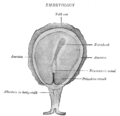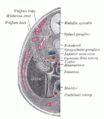Notochord
This article may be too technical for most readers to understand. (February 2017) |
| Notochord | |
|---|---|
nucleus pulposus | |
| Identifiers | |
| Latin | notochorda |
| MeSH | C000000 |
| TE | E5.0.1.1.0.0.8 |
| FMA | 85521 |
| Anatomical terminology] | |

In
The notochord is derived from the
The notochord is important for signaling the dorso-ventral patterning of cells coming from the mesodermal progenitors. This helps form the precursors needed for certain organs and the embryo to develop. In summary, the notochord plays essential roles in embryonic development.
The functions of the notochord include: providing a directional reference to the surrounding tissue as a midline structure during the
Presence
In
In tunicates the notochord is present only in the larval stage, becoming completely absent in the adult animal, and the notochord is not vacuolated.[2]
In all
Structure
The notochord is a long, rod-like midline structure that develops dorsal to the
Alternating contraction of
Role in signaling and development
The notochord plays a key role in signaling and coordinating development. Embryos of modern vertebrates form transient notochord structures during gastrulation. The notochord is found ventral to the neural tube.
Notogenesis is the development of the notochord by epiblasts that form the floor of the amnion cavity.[8] The progenitor notochord is derived from cells migrating from the primitive node and pit.[9] The notochord forms during gastrulation and soon after induces the formation of the neural plate (neurulation), synchronizing the development of the neural tube. On the ventral aspect of the neural groove an axial thickening of the endoderm takes place. (In bipedal chordates, e.g. humans, this surface is properly referred to as the anterior surface). This thickening appears as a furrow (the chordal furrow) the margins of which anastomose (come into contact), and so convert it into a solid rod of polygonal-shaped cells (the notochord) which is then separated from the endoderm.[citation needed]
In vertebrates, it extends throughout the entire length of the future vertebral column, and reaches as far as the anterior end of the
A postembryonic vestige of the notochord is found in the
In amphibians and fish
During development of amphibians and fish, the notochord induces development of the hypochord through secretion of vascular endothelial growth factor. The hypochord is a transient structure ventral to the notochord, and is primarily responsible for correct development of the dorsal aorta.[13]
Notochord flexion, when the notochord bends to form a part of the developing caudal fin, is a hallmark of an early growth stage of some fish.
In humans
By the age of 4, all notochord residue is replaced by a population of chondrocyte-like cells of unclear origin.[16] Persistence of notochordal cells within the vertebra may cause a pathologic condition: persistent notochordal canal.[17] If the notochord and the nasopharynx do not separate properly during embryonic development, a depression (Tornwaldt bursa) or Tornwaldt cyst may form.[18] The cells are the likely precursors to a rare cancer called chordoma.[19]
Neurology
Research into the notochord has played a key role in understanding the development of the central nervous system. By transplanting and expressing a second notochord near the dorsal neural tube, 180 degrees opposite of the normal notochord location, one can induce the formation of motor neurons in the dorsal tube. Motor neuron formation generally occurs in the ventral neural tube, while the dorsal tube generally forms sensory cells.[20]
The notochord secretes a protein called
Evolution in chordates
The notochord is the defining feature (
.The Ordovician oceans included many diverse species of Agnatha and early Gnathostomata which possessed notochords, either with attached bony elements or without, most notably the conodonts,[23] placoderms,[24] and ostracoderms. Even after the evolution of the vertebral column in chondrichthyes and osteichthyes, these taxa remained common and are well represented in the fossils record. Several species (see list below) have reverted to the primitive state, retaining the notochord into adulthood, though the reasons for this are not well understood.
Scenarios for the evolutionary origin of the notochord were comprehensively reviewed by Annona, Holland, and D'Aniello (2015).[25] They point out that, although many of these ideas have not been well supported by advances in molecular phylogenetics and developmental genetics, two of them have actually been revived under the stimulus of modern molecular approaches (the first proposes that the notochord evolved de novo in chordates, and the second derives it from a homologous structure, the axochord, that was present in annelid-like ancestors of the chordates). Deciding between these two scenarios (or possibly another yet to be proposed) should be facilitated by much more thorough studies of gene regulatory networks in a wide spectrum of animals.
Post-embryonic retention
In most vertebrates, the notochord develops into secondary structures. In other chordates, the notochord is retained as an essential anatomical structure. The evolution of the notochord within the phylum Chordata is considered in detail by Holland and Somorjai (2020). Vertebrates now have spines so they don't need a notochord. [26]
The following organisms retain a post-embryonic notochord:
- Acipenseriformes (paddlefish and sturgeon)[27]
- Lancelet (Amphioxus)
- Tunicate (larval stage only)
- Hagfish
- Lamprey
- Coelacanth
- African lungfish
- Tadpoles
- Ostracoderms (extinct)
Within Amphioxus
The notochord of the lancelet protrudes beyond the anterior end of the neural tube. This projection serves a second purpose in allowing the animal to burrow within the sediment of shallow waters. There, amphioxus is a filter feeder and spends most of its life partially submerged within the sediment.[7]
Additional images
-
Surface view of embryo of Concolor gibbon (Hylobates concolor).
-
Diagram of a transverse section, showing the mode of formation of the amnion in the chick.
-
Section through the head of a human embryo, about twelve days old, in the region of the hind-brain.
-
Transverse section of human embryo eight and a half to nine weeks old.
References
- ^ Schifferl, D., Scholze-Wittler, M., Villaronga Luque, A., Pustet, M., Wittler, L., Veenvliet, J. V., Koch, F., & Herrmann, B. G. (2023). Genome-wide identification of notochord enhancers comprising the regulatory landscape of the brachyury locus in mouse. Development (Cambridge, England), 150(22). https://doi.org/10.1242/dev.202111
- ^ Wang, F., Zhang, C., Shi, R., Xie, Z.-Y., Chen, L., Wang, K., Wang, Y.-T., Xie, X.-H., & Wu, X.-T. (2018). The embryonic and evolutionary boundaries between notochord and cartilage: A new look at nucleus pulposus-specific markers. Osteoarthritis and Cartilage, 26 (10), 1274–1282. https://doi.org/10.1016/j.joca.2018.05.022
- ISBN 978-3-13-582403-1.
- PMID 15890825.
- S2CID 219725868, retrieved 2023-01-14
- .
- ^ OCLC 53074665.
- ^ "The trilaminar germ disk (3rd week)". www.embryology.ch. Archived from the original on 2017-05-31. Retrieved 2012-01-09.
- ISBN 9780123302151.)
{{cite journal}}: CS1 maint: multiple names: authors list (link - ^ Henry Gray (1918). Anatomy of the Human Body. Lea & Febiger. pp. 52–54.
- ISBN 978-1-4557-2791-9.
- PMID 19035356.
- PMID 10648245.
- ^
Paxton, John R.; Johnson, G. David; Trnski, Thomas (2001). "Larvae and juveniles of the deepsea "whalefishes" Barbourisia and Rondeletia (Stephanoberyciformes: Barbourisiidae, Rondeletiidae), with comments on family relationships" (PDF). Records of the Australian Museum. 53 (3): 407–425. doi:10.3853/j.0067-1975.53.2001.1352. Archived from the original(PDF) on 2003-09-26.
- ^
"Brownsnout spookfish" (PDF). Ichthyoplankton Information System. Alaska Fisheries Science Center. National Oceanographic and Atmospheric Administration. July 2008. Retrieved 14 March 2009.
- .
- PMID 9974055.
- PMID 17315835.
- PMID 29881220.
- PMID 15936325.
- S2CID 6732599.
- ISBN 978-0-697-21991-6.
- ^ "Palaeos Vertebrates 30.000 Conodonta: Overview". Archived from the original on 2006-03-13. Retrieved 2007-09-05.
- ^ "Palaeos Vertebrates 60.000 Placoderm Overview". Archived from the original on 20 December 2010. Retrieved 21 November 2009.
- PMID 26446368.
- PMID 33088474.
- ISBN 978-94-017-1356-6.




